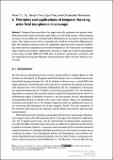6 Principles and applications of temporal-focusing wide-field two-photon microscopy
Author(s)
So, Peter T. C.; Choi, Heejin; Yew, Yan Seng Elijah; Rowlands, Christopher
Download[9783110429985 - Multiphoton Microscopy and Fluorescence Lifetime Imaging] 6 Principles and applications of temporal-focusing wide-field two-photon microscopy.pdf (50.96Mb)
PUBLISHER_CC
Publisher with Creative Commons License
Creative Commons Attribution
Terms of use
Metadata
Show full item recordAbstract
Temporal focusing allows for rapid optically sectioned two-photon widefield microscopy. Depth sectioning is provided in a wide-field manner, without spatial focusing, by controlling the temporalwidth of femtosecond laser pulses near the focal plane. This spatial control of the temporal pulse width is achieved by diffracting the light off a grating resulting in spectral component separation and temporal broadening; these spectral components are only recombined at the focal plane to reproduce short, femtosecond pulses. Applications include (i) high speed functional imaging in the brain, (ii) fast FLIM and PLIM, (iii) cell-selective optogenetic excitation, and (iv) temporal focusing photodynamic therapy that may allow selective killing of cancer cells.
Date issued
2018-01Department
Massachusetts Institute of Technology. Department of Mechanical EngineeringJournal
Multiphoton Microscopy and Fluorescence Lifetime Imaging
Citation
So, Peter T. C., Heejin Choi, Elijah Yew, and Christopher Rowlands. “6 Principles and Applications of Temporal-Focusing Wide-Field Two-Photon Microscopy.” Multiphoton Microscopy and Fluorescence Lifetime Imaging, edited by Karsten König, 2018, pp. 103–140. © 2018 Peter T. C. So et al.
Version: Final published version
ISBN
9783110438987